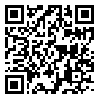Mon, May 6, 2024
Volume 6, Issue 1 (Winter 2020)
Caspian J Neurol Sci 2020, 6(1): 16-30 |
Back to browse issues page
Download citation:
BibTeX | RIS | EndNote | Medlars | ProCite | Reference Manager | RefWorks
Send citation to:



BibTeX | RIS | EndNote | Medlars | ProCite | Reference Manager | RefWorks
Send citation to:
Raiesdana S. Automated Detection of Multiple Sclerosis Lesions Using Texture-based Features and a Hybrid Classifier. Caspian J Neurol Sci 2020; 6 (1) :16-30
URL: http://cjns.gums.ac.ir/article-1-303-en.html
URL: http://cjns.gums.ac.ir/article-1-303-en.html
Faculty of Electrical, Biomedical, and Mechatronics Engineering, Qazvin Branch, Islamic Azad University, Qazvin, Iran , somayeh.rdana@gmail.com
Abstract: (2273 Views)
Background: Multiple Sclerosis (MS) is the most frequent non-traumatic neurological disease capable of causing disability in young adults. Detection of MS lesions with magnetic resonance imaging (MRI) is the most common technique. However, manual interpretation of vast amounts of data is often tedious and error-prone. Furthermore, changes in lesions are often subtle and extremely unrepresentative.
Objectives: To develop an automated non-subjective method for the detection and quantification of MS lesions.
Materials & Methods: This paper focuses on the automatic detection and classification of MS lesions in brain MRI images. Two datasets, one simulated and the other one recorded in hospital, are utilized in this work. A novel hybrid algorithm combining image processing and machine learning techniques is implemented. To this end, first, intricate morphological patterns are extracted from MRI images via texture analysis. Then, statistical textures-based features are extracted. Afterward, two supervised machine learning algorithms, i.e., the Hidden Markov Model (HMM) and Adaptive Neuro-Fuzzy Inference System (ANFIS) are employed within a hybrid platform. The hybrid system makes decisions based on ensemble learning. The stacking technique is used to apply predictions from both models o train a perceptron as a decisive model.
Results: Experimental results on both datasets indicate that the proposed hybrid method outperforms HMM and ANFIS classifiers with reducing false positives. Furthermore, the performance of the proposed method compared with the state-of-the-art methods, was approved.
Conclusion: Remarkable results of the proposed method motivate advanced detection systems employing other MRI sequences and their combination.
Objectives: To develop an automated non-subjective method for the detection and quantification of MS lesions.
Materials & Methods: This paper focuses on the automatic detection and classification of MS lesions in brain MRI images. Two datasets, one simulated and the other one recorded in hospital, are utilized in this work. A novel hybrid algorithm combining image processing and machine learning techniques is implemented. To this end, first, intricate morphological patterns are extracted from MRI images via texture analysis. Then, statistical textures-based features are extracted. Afterward, two supervised machine learning algorithms, i.e., the Hidden Markov Model (HMM) and Adaptive Neuro-Fuzzy Inference System (ANFIS) are employed within a hybrid platform. The hybrid system makes decisions based on ensemble learning. The stacking technique is used to apply predictions from both models o train a perceptron as a decisive model.
Results: Experimental results on both datasets indicate that the proposed hybrid method outperforms HMM and ANFIS classifiers with reducing false positives. Furthermore, the performance of the proposed method compared with the state-of-the-art methods, was approved.
Conclusion: Remarkable results of the proposed method motivate advanced detection systems employing other MRI sequences and their combination.
Keywords: Multiple sclerosis, Magnetic resonance imaging
Type of Study: Research |
Subject:
Special
Received: 2020/05/23 | Accepted: 2020/05/23 | Published: 2020/05/23
Received: 2020/05/23 | Accepted: 2020/05/23 | Published: 2020/05/23
Send email to the article author
| Rights and permissions | |
 | This work is licensed under a Creative Commons Attribution-NonCommercial 4.0 International License. |






